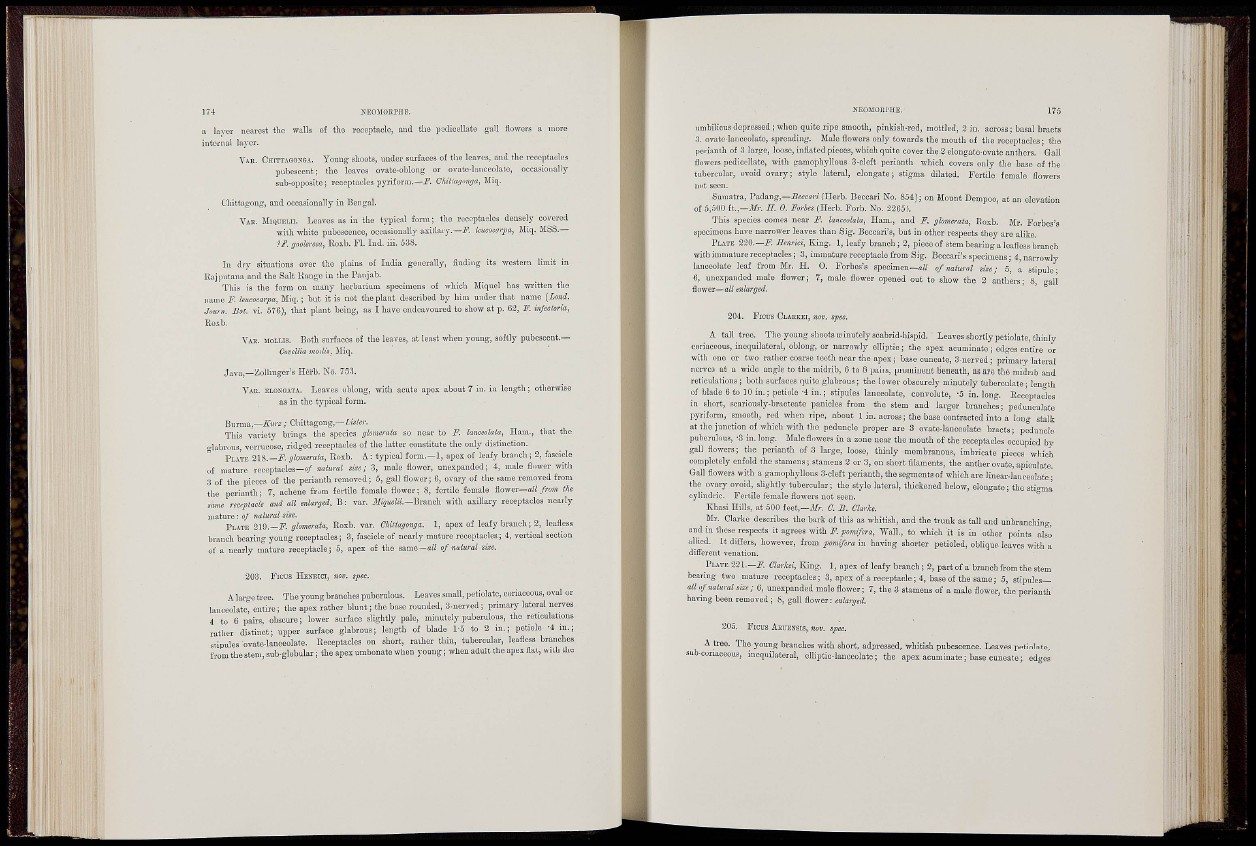
] 74 KEOMOEPHF.
a layer nearest tho walls of the recoptacle, and tlie pedicellate gall flowers a more
internal layer.
Var. CntTTAGOSGA. Young sLoots, under sm-faces of the leaves, and the receptacles
pubescent; the leaves ovate-oblong- or ovate-huiccolate, occasionally
sub-opposite; receptacles pyrlform.— 'F. OUtiaf/onga, Miq.
Ohittagong, and occasionally in Bengal.
Var. Miquelii. Leaves as in the typical form; the receptacles densely covered
with white pubescence, occasionally axillary.—i?. Icucocorpa, Mitp MSS.—
goolereea, Roxb. Fl. Ind. iii. 538.
In dry situations over the plains of India generally, finding its western limit in
Uajpiitana and the Salt Kange in the Panjab.
This is the form on many herbarium specimens of which Miquel has written the
name F. leucocarpa, Miq. ; but it is not the plant described by him under that name [Lond.
Journ. Boi. vi. 576), that plant being, as I have endeavoui-ed to show at p. 62, F. infectoria,
Ro.Nb.
Vak. mollis. Both surfaces of the leaves, at least when young, softly pubescent,—
Covellia modis, Miq.
Java,—Zollinger's Herb, No. 753.
Var. elongata. Leaves oblong, with acute apes about 7 in. in length ; otherwise
as in the typical form.
Burma,—Ziirg ; Chittagong,—¿¿sfor.
This variety brings tlie species glomeraia so near to F. lanceolata^ Ham., that the
glabrous, verrucose, ridged receptacles of the latter constitute the only distinction.
P l a t e 218.-^*. glomerata, Rosb. A : typical form.—1, apes of leafy branch ; 2, fascicle
oi mature recoptacles-o/ natural size; 3, male flower, unexpanded; 4, male fl..wer with
3 of the pieces of the perianth removed ; 5, gall flower ; 6, ovary of the same removed from
the perianth ; 7, achene fi-om fertile female flower ; 8, fertile female flower—froin the
same rec^piaeU and all enlarged. B : var. iliijaeZii.-Branch with axillaiy receptacles nearly
mature : of natural size.
P l a t e 219.—i". glomerata, Rosb. var. CMtiugonga. I, apex of leafy branch; 2, leafless
branch bearing young receptacles ; 3, fascicle of nearly mature receptacles; 4, vertical section
of a nearly mature receptacle; 5, apex of the same —a/i of natural size.
203. Ficus Hesrici, nov. spec.
A large ti-ce. The young branches pubernlous. Leaves small, pctiolate, coriaceous, oval or
lanceolate^ entire ; the apex rather blunt ; the base rounded, 3-nerved ; primary lateral nerves
4 to 6 pahs, obscm-e; lower sui-face slightly pale, minutely puberulous, the reticulations
rather distinct; upper surface glabrous; length of blade 1-5 to 2 in.; petiole -4 m. ;
,Tiles ovate-lanceolate. Receptacles on short, rather thin, tubercular, leafless branches
n t h e stem, sub-globular ; the apes umbonate when young ; when adult the apex flat, with the
neomorphe. 175
umbilicus depressed; when quite ripe smooth, pinkish-red, mottled, 2 in. across; basal bracts
3. ovate lanceolate, spreading. Male flowers only towards the mouth of the receptacles; the
perianih of 3 large, loose, inflated pieces, which quite cover the 2 elongate-ovate anthers. Gall
flowers pedicellate, with gamophyllous 3-cJeft perianth which covers only the base of the
tubercular, ovoid ovary; style lateral, elongate; stigma dilated. Fertile female flowers
not seen.
Sumatra, Padang,—-Bician ("Herb. Beccari No. 854); on Mount Dempoo, at an elevation
of 5,500 it.,—Mr. H. 0. Forbes (Herb. Forb. No. 2265).
This species comes near F. lanceolata, Ham., and F. glomerata, Roxb. Mr. Forbes's
specimens have narrower leaves than Sig. Beccari's, but in other respects they are alike.
P l a t b 220.—i?'. Menrici, King. 1, leafy branch; 2, piece of stem bearing a leafless branch
with immature receptacles; 3, immature receptacle from Sig. Beccari's specnnens; 4, narrowly
lanceolate leaf from Mr. H. O. Forbes's specimen—a^/ of natural size; 5, a stipule;
6, unexpanded male flower; 7, male flower opened out to show the 2 anthers; 8, gall
flower—all enlarged.
204. Ficus Clarkei, nov. spee.
A tall tree. The young shoots minutely scabrid-hispid. Leaves shortly petiolate, thinly
coriaceous, inequilateral, oblong, or naiTowly elliptic; the apex acuminate; edges entire or
with one or two rather coarse teeth near the apex; base cuneate, 3-nerved ; primary lateral
nerves at a wide angle to the midrib, 6 to 8 pairs, promment beneath, as are the midrib and
reticulations; both surfaces quite glabrous; the lower obscurely minutely tuberculate; length
of blade 6 to 10 in. ; petiole -4 in. ; stipules lanceolate, convolute, -5 in. long. Receptacles
in short, scariously-bracteate panicles from the stem and larger branches; pedunculate
pyriform, smooth, rod when ripe, about 1 in. across; the base contracted into a long stalk
at the junction of which with the peduncle proper are 3 ovate-lanceolate bracts; peduncle
puberulous, -3 in. long. Maleflowers in a zone near the mouth of the receptacles occupied by
gall flowers; the perianth of 3 large, loose, thinly membranous, imbricate pieces which
completely enfold the stamens; stauiens 2 or 3, on short filaments, the anther ovate, apiculate.
Gall flowers with a gamophyllous 3-cleft perianth, the segments of which are linear-lanceolate •
the ovaiy ovoid, slightly tubercular; the style lateral, thickened below, elongate; the stigma
cylmdric. Fertile female flowers not seen.
Khasi Hills, at 500 feet,—jlf?-, C. B. Clarke.
Mr. Clarke describes the bark of this as whitish, and the trunk as tall and unbranching,
1 these respects it agrees with F. pomifm-a, Wall., to which 'it is in other points also
I having shorter petioled, obliq:
points also
leaves with a
and in
allied. It differs, however, from pomifera
different venation.
P l a t e 221.—J", marlcei, King. 1, apex of leafy branch; 2, part of a branch from the stem
bearing two mature receptacles; 3, apex of a receptacle; 4, base of the same; 5, stipules—
all K>f natural size ; 6, unexpanded male flower; 7, the 3 stamens of a male flower, the perianth
having been removed; 8, gall flower: enlarged.
205. Ficus Akuensis, nov. spec.
A tree. The young branches with short, adpressed, whitish pubescence. Leaves petiolate,
sub-coriaceous, inequilateral, elliptic-lanceolate; the apex acuminate; base cuneate; edges